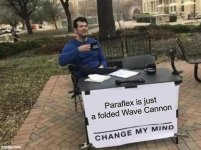You vented the front and rear chambers into a vented common chamber. You added a 2nd order to the BP6P, hence BP8P.Why 8th? It’s just two separate resonators 60cm long (folded) and 30cm long(folded) and the cancelation is centered on the total as 180cm/4 in horn response (192hz) I notice…. So these are actually ‘1/4 wave resonators I suppose?
You need to use the BP8P function and see if HR matches your built measurement.
I have quite a few of those, but I ALWAYS taper the opposite direction because it sounds so much better (resonances/harmonics are based on a much shorter length and none of the nasty sounds and honk/ring seems to be there like in the ‘horn’ shaped expansions ?
Again, maybe just a play on words/descriptions and not any actual change in the measured frequency response or creating a new electrical impedance to witness? As a result of exiting at the same place verses spread out(unless looking at really high frequencies Maybe?)You vented the front and rear chamber into a vented common chamber. You added a 2nd order to the BP6P, hence BP8P.
did connecting the exits make my ‘paraflex’ ring like crazy and sound bizarre? Or would seperating the exits apart help/worsen that?
Geez, I guess a Paraflex is a BP8P enclosure.
All the folds make the enclosure look like a BP6S.


All the folds make the enclosure look like a BP6S.
Something has to be the same when comparing the 2 enclosures, either same tune, volume, dB level.
That's the point I was making. For a valid comparison you can only change one. When you say:
Positive tapering = efficiency, low, and big enclosure.
Negative tapering = inefficiency, low, and small enclosure.
Several variables have changed: taper & enclosure volume, and potentially Fb also unless you have altered the pipe length to account for the effect of taper on its fundamental. A reverse taper pipe, as in one tapering toward the terminus is inherently mass loaded, so for a given physical length it's tuned lower than an untapered pipe or an expanding pipe (horn), which as always comes at the price of efficiency. But there's no requirement for it to be a 'small enclosure', i.e. have its volume reduced relative to the others. By doing that, you're reducing efficiency compared to the others from that source as well as the lower Fb.
Yeah, most(if not all) of that paraflex stuff is just resonating/ringing garbage and not worth building as a result . very strange and desperate way to get loud that woukd have been ‘better’ as a simple tapped horn with single resonator path ?
Again, maybe just a play on words/descriptions and not any actual change in the measured frequency response or creating a new electrical impedance to witness? As a result of exiting at the same place verses spread out(unless looking at really high frequencies Maybe?)
did connecting the exits make my ‘Paraflex’ ring like crazy and sound bizarre? Or would separating the exits apart help/worsen that?
It's not a play on words.
1 vented chamber + 1 sealed chamber = 4 orders.
2 vented chambers = 6 orders.
3 vented chambers = 8 orders.
The PH function is for series tuned enclosures.
You built a parallel tuned enclosure.
Before DMB added the PH function to HR, I always thought PH's behaved like a parallel tuned enclosure in folks' series tuned (TH) models due to the front chamber port was exiting so close to the enclosure's mouth.
Now, I can SEE that PH's are BP8P's. I think the original Paraflex thread might have mentioned the enclosure is an 8th order.
That's the point I was making. For a valid comparison you can only change one. When you say:
Positive tapering = efficiency, low, and big enclosure.
Negative tapering = inefficiency, low, and small enclosure.
Changing 1 parameter = Hofmann's Iron Law...efficient, low, small...pick 2.
Is my ‘paraflex’ an 8th order? There isnt much of a ‘chamber’ there where the resonator exits converge, but their sharing the same location ?It's not a play on words.
1 vented chamber + 1 sealed chamber = 4 orders.
2 vented chambers = 6 orders.
3 vented chambers = 8 orders.
The PH function is for series tuned enclosures.
You built a parallel tuned enclosure.
Before DMB added the PH function to HR, I always thought PH's behaved like a parallel tuned enclosure in folks' series tuned (TH) models due to the front chamber port was exiting so close to the enclosure's mouth.
Now, I can SEE that PH's are BP8P's. I think the original Paraflex thread might have mentioned the enclosure is an 8th order.
Attachments
Last edited:
🤓🤓🤓It's not a play on words.
1 vented chamber + 1 sealed chamber = 4 orders.
2 vented chambers = 6 orders.
3 vented chambers = 8 orders.
The PH function is for series tuned enclosures.
You built a parallel tuned enclosure.
Before DMB added the PH function to HR, I always thought PH's behaved like a parallel tuned enclosure in folks' series tuned (TH) models due to the front chamber port was exiting so close to the enclosure's mouth.
Now, I can SEE that PH's are BP8P's. I think the original Paraflex thread might have mentioned the enclosure is an 8th order.
Attachments
TH = BP6S.
PH = BP8P.
This is why a PH is a BP8P.
Yellow = the 3 chambers.
Green = the 3 ports.

PH = BP8P.
This is why a PH is a BP8P.
Yellow = the 3 chambers.
Green = the 3 ports.
To be a BP8S, either chamber 1 would have to vent into chamber 2 or chamber 2 would have to vent into chamber 1.

Is my ‘paraflex’ an 8th order? There isnt much of a ‘chamber’ there where the resonator exits converge, but their sharing the same location ?
Based on this graph, yes!
3 U's or 4 peaks = 8th order.
Ph1, L45 is essentially 0.01 cm (or the thickness of the material if one wanted to geek out on things that don’t actually matter?)
- Home
- Loudspeakers
- Subwoofers
- An idea: A T-line with both ends open


